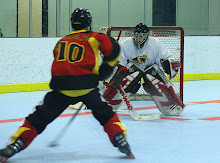Monday, December 7, 2009
Happy Holidays
The First Semester has officially come to a close as teams will be heading home to enjoy the holidays. This will be the final rankings to be released for quite some time.
In Division I, Lindenwood will be heading into the break in a familiar spot, having been ranked #1 for 49 consecutive days.
In Division II, Grand Valley State used a strong final weekend to sneak past West Chester and into the top spot for the third time this season. All signs point to a West Chester vs Grand Valley State national title game, which would be a rematch of last years thrilling semi-final.
In Junior College Action, Saddleback College has been the run away favorite in the division, extending their stay at #1 to JuCo record setting 371 days.
In the B Division, Lindenwood Gold was enjoying a run of 271 days on top of the leader board until the final weekend of the semester when Penn State passed them in the rankings.
In Division I, Lindenwood will be heading into the break in a familiar spot, having been ranked #1 for 49 consecutive days.
In Division II, Grand Valley State used a strong final weekend to sneak past West Chester and into the top spot for the third time this season. All signs point to a West Chester vs Grand Valley State national title game, which would be a rematch of last years thrilling semi-final.
In Junior College Action, Saddleback College has been the run away favorite in the division, extending their stay at #1 to JuCo record setting 371 days.
In the B Division, Lindenwood Gold was enjoying a run of 271 days on top of the leader board until the final weekend of the semester when Penn State passed them in the rankings.
Subscribe to:
Post Comments (Atom)
The Rankings Explained
Since the conclusion of the season both founders set out to find the best solution to answer the age old question, “Who’s #1?” After much search, the answer was to use a mathematical formula to calculate the answer. Removing the human element from the voting would likely result in less biased rankings towards individual teams and regions.
The solution would be found in the ELO chess rating system. They system was created to rank chess players by another means that wins, losses and draws. The system uses a mathematical formula to reward each person for impressive feats and punish them for lesser impressive feats. Because chess and inline hockey are two different animals, the general equation had to be changed to allow for more hockeys related factors into the equation.
Using the FIFA Women’s World Rankings as a guideline (Elo Based), we managed to change the rankings to suit the nature of our sport. The rankings include the importance of the game, the outcome of the game, the expected result of the game, and the goal differential of the game when calculating a result. To better explain the way the rankings work I give you the following examples (all team start with a ranking of 1500):
Lindenwood University (1500) vs. UMSL (1500): If Lindenwood won the regular season game 4-3; they would be awarded 15 points for the victory and UMSL would be docked 15 points. However, if the game was won 12-2, Lindenwood would earn 39.38 points for the victory and UMSL would be docked 39.38 points. Additionally, the importance of the game could change, using the national title game as the example, with both teams having equal ratings Lindenwood would be awarded 52.5 points for a 6-3 win.
However, as you could assume, two teams having the same rating would be rare. Each teams point total carries over from one week to the next and from one season to the next. The following is a example of two teams with different point values and the different results it can produce.
Lindenwood University (1746.38) vs. Illinois State (1360.88): There are a few things that you can determine because of the vast difference in each teams rating (385.5). The first is that Lindenwood is expected to win the game. The second is that Illinois State winning the game would be a much bigger accomplishment that Lindenwood winning the game. The maximum points Lindenwood can earn from this game is 7.72, which would mean they won by at least 10 goals. However, on the flip side, if Illinois State was to win the game by at least 10 goals they could earn as many as 71.03 points. This is based on the projection that Lindenwood would win the match-up 90% of the time.
As the two examples show, there are a bunch of positives when using this system. For starters, once a team has achieved a high rating, it becomes difficult for them to increase it without playing a higher level of competition. This rewards regions that have more competitive teams. It also rewards teams who travel out of the region and win games against other higher rated teams. For example, last season, Towson and Army both played James Madison who would have had a higher rating that both visiting teams. In the games, Army and Towson both won handily and would have increased their ratings while negatively hurting James Madison. But, the hidden bonus is they now can bring those rating points back into their region. Those points then become spread out over the entire region as the season progresses and teams win and lose.
For the ratings system to work, each game has to have a certain amount of value attached to it. In the system we will be using five different levels to rate the importance of any give game. The first level is the lowest level of importance; it contains all pre-season exhibition games. The second level includes all regular-season regional games, as well as cross-divisional exhibition games. Level three includes all cross-regional games and invitational based tournaments, like WinterFest. The fourth level includes all regional playoff games and the fifth and final level includes all national playoff games.
The solution would be found in the ELO chess rating system. They system was created to rank chess players by another means that wins, losses and draws. The system uses a mathematical formula to reward each person for impressive feats and punish them for lesser impressive feats. Because chess and inline hockey are two different animals, the general equation had to be changed to allow for more hockeys related factors into the equation.
Using the FIFA Women’s World Rankings as a guideline (Elo Based), we managed to change the rankings to suit the nature of our sport. The rankings include the importance of the game, the outcome of the game, the expected result of the game, and the goal differential of the game when calculating a result. To better explain the way the rankings work I give you the following examples (all team start with a ranking of 1500):
Lindenwood University (1500) vs. UMSL (1500): If Lindenwood won the regular season game 4-3; they would be awarded 15 points for the victory and UMSL would be docked 15 points. However, if the game was won 12-2, Lindenwood would earn 39.38 points for the victory and UMSL would be docked 39.38 points. Additionally, the importance of the game could change, using the national title game as the example, with both teams having equal ratings Lindenwood would be awarded 52.5 points for a 6-3 win.
However, as you could assume, two teams having the same rating would be rare. Each teams point total carries over from one week to the next and from one season to the next. The following is a example of two teams with different point values and the different results it can produce.
Lindenwood University (1746.38) vs. Illinois State (1360.88): There are a few things that you can determine because of the vast difference in each teams rating (385.5). The first is that Lindenwood is expected to win the game. The second is that Illinois State winning the game would be a much bigger accomplishment that Lindenwood winning the game. The maximum points Lindenwood can earn from this game is 7.72, which would mean they won by at least 10 goals. However, on the flip side, if Illinois State was to win the game by at least 10 goals they could earn as many as 71.03 points. This is based on the projection that Lindenwood would win the match-up 90% of the time.
As the two examples show, there are a bunch of positives when using this system. For starters, once a team has achieved a high rating, it becomes difficult for them to increase it without playing a higher level of competition. This rewards regions that have more competitive teams. It also rewards teams who travel out of the region and win games against other higher rated teams. For example, last season, Towson and Army both played James Madison who would have had a higher rating that both visiting teams. In the games, Army and Towson both won handily and would have increased their ratings while negatively hurting James Madison. But, the hidden bonus is they now can bring those rating points back into their region. Those points then become spread out over the entire region as the season progresses and teams win and lose.
For the ratings system to work, each game has to have a certain amount of value attached to it. In the system we will be using five different levels to rate the importance of any give game. The first level is the lowest level of importance; it contains all pre-season exhibition games. The second level includes all regular-season regional games, as well as cross-divisional exhibition games. Level three includes all cross-regional games and invitational based tournaments, like WinterFest. The fourth level includes all regional playoff games and the fifth and final level includes all national playoff games.










6 comments:
I wouldnt say all things point to a rematch of grand valley and West chester considering west chester just took a lose to brockport. There is still alot of top team matchups in the east
West Chester does still have some work ahead of them. Inter regionals will give us a better picture. Grand Valley looks to be better than last year. They pulled off an impressive win against michigan state. Cincinnati gave them their only challenge in DII so far.
neumann gets upgrades next semester look out.
Neumann is old news.
The fact that Brockport, though not playing Neumann or Rowan yet, beat West Chester in the regular season and in preseason would suggest that they are a better overall team. Why all signs point to them in the finals when they lost... and Brockport is the only undefeated team (again without playing Rowan or Neumann) and they dont even get a nod?
Grand Valley didn't play West Chester in the Semis. It was the quarters. Missouri State played Grand Valley in the semis
Post a Comment